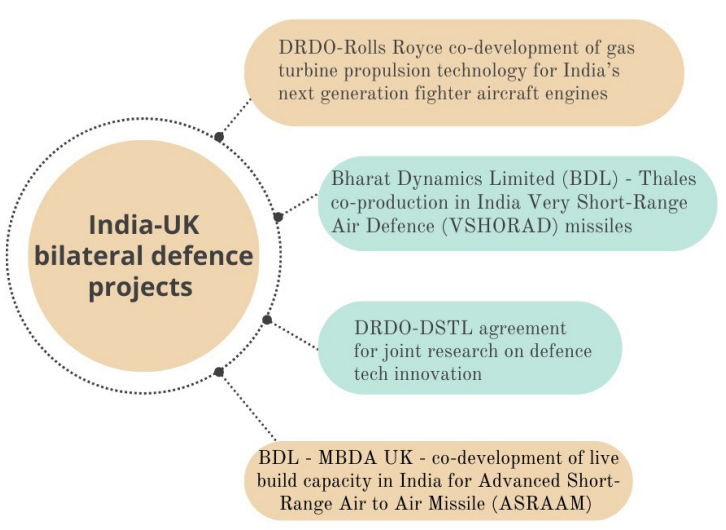Syllabus: GS2/International Relations
Context
- India and the United Kingdom have signed multiple agreements aimed at enhancing bilateral defence collaboration.
Key Agreements and Collaborations
- Defence Partnership–India (DP-I): Establishment of a dedicated programme office within the UK’s Ministry of Defence to serve as a one-stop hub for bilateral defence collaboration.
- Aims to facilitate deeper cooperation and support economic growth in both countries.
- Laser Beam Riding MANPADs (LBRM): India and the UK signed a contract for the delivery of Laser Beam Riding Man Portable Air Defence Systems (MANPADS).
- The initial supply of High Velocity Missiles (STARStreak) and launchers is set for delivery this year.
- Lightweight Multirole Missiles (LMM): Focuses on integrating Indian and British industries into the global defence supply chain.
- Advanced Short-Range Air-to-Air Missile (ASRAAM): Collaboration to establish an ASRAAM assembly and testing facility in Hyderabad.
- Integrated Full Electric Propulsion (IFEP) System: A Statement of Intent was signed to design and develop an Integrated Full Electric Propulsion (IFEP) system for India’s next-generation Landing Platform Dock (LPD) fleet.
- Both nations are working to establish India’s first maritime Land-Based Testing Facility, with a goal to deliver the LPD in water by 2030.

| Defense Cooperation Between India and UK – Over the past decade, only about 3% of India’s defence acquisitions came from the UK. – Modern Collaborative Frameworks: 1. Defense and International Security Partnership (DISP), 2015: It aims to enhance cooperation in areas such as counter-terrorism, cyber security, and defense manufacturing. 2. Defense Equipment Memorandum of Understanding (MoU): It facilitates collaboration between defense industries of both countries, promoting co-development and co-production initiatives. 1. India-UK 2+2 Foreign and Defence Dialogue. – Joint Military Exercises and Training: 1. Exercise Ajeya Warrior; 2. Exercise Konkan; 3. Exercise Cobra Warrior; 4. Exercise Tarang Shakti. – Defense Industrial Collaboration: A Letter of Arrangement was signed between India’s DRDO and the UK’s DSTL to collaborate on defense research, emphasizing areas like Electric Propulsion Systems for the Indian Navy. – Maritime Cooperation: Promoting freedom of navigation and open access, and improving maritime cooperation, with a new Maritime Dialogue, Grey and Dark Shipping information sharing and mechanisms. |
Key Concerns
- India-UK defence cooperation has often been derailed by the ‘three-I’ challenge posed by Indian rules and regulations pertaining to:
- Foreign Investment;
- Intellectual Property Rights;
- Indigenous Content Requirements.
Strategic Significance
- These agreements represent a significant step forward in India-U.K. defence cooperation, particularly in critical areas such as air defence and maritime propulsion.
- It aligns with India’s Atmanirbhar Bharat (self-reliant India) vision, promoting indigenous defence capabilities and technological advancements.
Next article
India’s Pharmaceutical Exports Set for 10x Growth